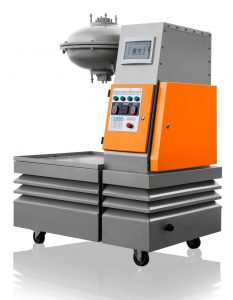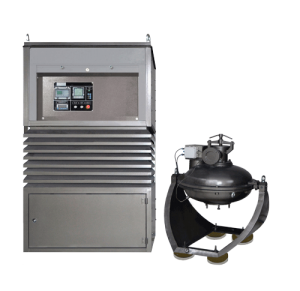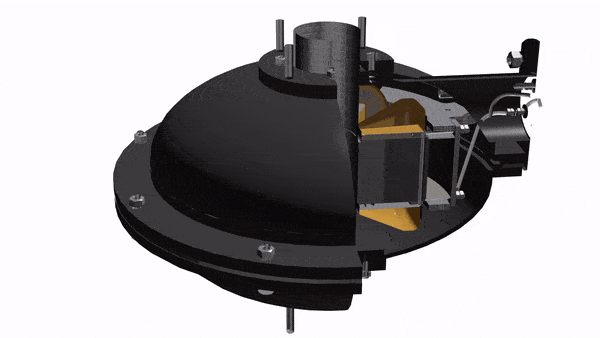Intensive dispersion of solid material with simultaneous particle activation can be applied in paint production and laquer production. Iron oxide pigments, for instance, can be dispersed to the size less than 20 micron in 15-60 seconds in the AVS vortex layer device; in a ball drum, the same process takes several hours.
Paint Production in AVS
The paint production industry uses predominantly three types of equipment: bead mills, ball drums and ring roller mills. Each has its own relatively narrow application range, all have limited production rate, high power consumption and complex servicing and repairs.
Vortex layer devices have demonstrated their efficiency in the dispersion process. This device has been improved and upgraded by GlobeCore engineers. The device consists of the a 60-330 mm diameter active chamber (tube), installed inside an inductor coil generating a rotating EM field. The active chamber is filled with anywhere from several dozen to several thousand (0.05 – 20 kg) cylindrical ferromagnetic elements, with the diameter of 0.50-5 mm, and the length of 5-60 mm.
When the inductor coil is energized, an alternating EM field is created inside the active chamber; the field affects all FM elements. With certain EM field parameters, each element will rotate at the rate equal to the frequency of the field, created by the induction coil.

Inside the active chamber, the film-forming paint material is subjected to the influence of the FM elements, which move along complex paths (due to collisions); the product is dispersed and then expelled through the outlet. The efficiency of the device allows it to replace four 4m3 ball drums and cuts energy costs more than 3 times.
The AVS vortex layer device is used for physical activation of the paint product. Steel needles are used as FM elements; in the EM field, the needles’ physical effect homogenizes the mixture. The particles of the dye are uniformly distributed throughout the volume of the product.
In the process of pigment pulverization, some FM element pulverization also occurs. This is not acceptable for white paint. However, for paints of other colors, some metal does not degrade the product, but actually often improves its performance.
The principle of AVS operation is based on the influence of the particles in the rotating EM field, the high energy and the mechanical impact of the elements (needles).
In the electromagnetic field, any material in the active zone are rapidly mixed, pulverized and made chemically active due to ionization. The energy applied causes deep change in the structure of the material and activates the interacting components regardless of their state: gaseous, liquid or solid.
The mills were tested in the production of water paint, which include chalk, talcum, titan dioxide and ultramarine. In the course of the experiments, paint of satisfactory quality was made in the mill within 1-2 minutes.
Dispersion of luminescent dyes in production of antifloating ink also yielded good results. The required dye particle size (below 2 micron) was obtained in the AVS within 5-6 minutes.
The influence of electromagnetic field improves quality, strength and durability of the paint product.
Printing ink to protect security paper from forging includes up to 60% of finely dispersed ferromagnetic powder of iron oxide with particle size of 0.005 – 0.5 micron.
The particles of printing ink can be encapsulated. The particles are coated by a layer of ionomer resin or oil, thixotropic material and/or a binding resin. This method excludes organic solvents and cuts the cost of dispersing the capsulated dyes or black in the required binder.

AVS-150 vortex layer device for paint production
One of the ferromagnetic paints contains oil or varnish based on a synthetic polymer (30-40% by weight) and ceramic carbonyl iron or 30-80 micron ground ferrite (60-70% by weight). The paint is only used for blackboard. It creates a smooth surface, contrasting the chalk and with magnetic properties to attach sheets of paper (drawings, posters or diagrams) using small magnets. The cost of such a blackboard is 50-80% less than a linoleum blackboard and 10-20 times less than that of a glass blackboard.
Another water-solved magnetic paint has been developed for application on concrete, cement, plaster or chipboard surfaces. Due to the properties of the paint, the magnetic powder immediately sticks to the surface, endowing it with magnetic properties. Notes can be attached to the surface with small magnets. The magnetic paint is black, but once applied, it can be painted over by any other color. The paint is safe to children (lead free). The paint is matte, water soluble for special indoor applications. Not only does the paint protect the surface, it also attracts magnets to the painted surface. Thus, the surface turns into an information panel which requires no pins, nails or glue.

Researches also look into the influence of the magnetic field on elastic and viscous properties of rubber ferrites. It has been determined that the magnetic field, where the material is placed, strongly affects its elasticity and viscosity, increasing effective viscosity and Young’s modulus.
Another direction of research are porous polymers, hydrogels and polymer fibers, modified by magnetic liquid particles. The process of permeating the hydrogel and polymer pores by the magnetic particles of the magnetic liquids was studied both in and outside of a magnetic field. It has been determined that external gradient magnetic field improves the depth of permeation of hydrogel with magnetic liquid. The research also considered the conditions of material production and the magnetic qualities of the new magnetically controller highly elastic materials, the thickness of magnetic coating was estimated as well. The experiments showed that the thickness of the coat depends on the concentration of the magnetic liquid, pH of the environment, surface charge and the method of pro-processing. An elastic magnetically controlled caoutchouc-based composite, containing magnetic filler, plasticizer and a binding agent, was developed. The material changes its shape and size in a magnetic field and returns to normal when the field is removed.

